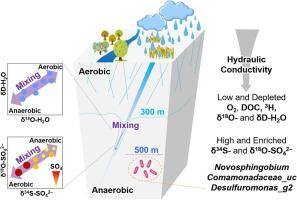当前位置:
X-MOL 学术
›
J. Hazard. Mater.
›
论文详情
Our official English website, www.x-mol.net, welcomes your
feedback! (Note: you will need to create a separate account there.)
Evaluating Radionuclide Mobility in Groundwater Recharge Areas of Fractured Natural Barrier Systems using Multiple Isotopes and Microbial Indicators
Journal of Hazardous Materials ( IF 12.2 ) Pub Date : 2024-11-19 , DOI: 10.1016/j.jhazmat.2024.136571 YeoJin Ju, Kyung-Woo Park, Eunhye Kwon, Dugin Kaown, Seong Chun Jun, Jiwon Park, Kang-Kun Lee
Journal of Hazardous Materials ( IF 12.2 ) Pub Date : 2024-11-19 , DOI: 10.1016/j.jhazmat.2024.136571 YeoJin Ju, Kyung-Woo Park, Eunhye Kwon, Dugin Kaown, Seong Chun Jun, Jiwon Park, Kang-Kun Lee

|
The distribution of uranium (U) concentrations, which reached up to 322 µg/L, was found to correlate with the pattern of fractures within the natural barrier system (NBS). Analysis of the vertical distribution of dissolved oxygen (DO), dissolved organic carbon (DOC), tritium (3H), microbial communities, and H2O and SO42– isotopes revealed insights into oxic water infiltration within the heterogeneous fractured system. Their distribution showed that the average infiltration depth at the KURT site is 200 m, while in external areas with a high frequency of fractures, oxic conditions extended down to 495 m. The SO42– isotopes suggested the potential for microbial sulfate reduction to play a role in regulating radionuclide mobility in the deep geological system. At approximately 500 m, genera capable of thriving under harsh conditions of low DO and high heavy metal concentrations, such as Novosphingobium, Comamonadaceae_uc, and Desulfuromonas_g2, were identified. These findings indicate hydrogeological variability and microbial adaptation within the deep NBS, highlighting the importance of understanding the deep geological environment for evaluating microbiome performance in regulating toxic radionuclides within repository systems. Overall, this study emphasizes the pivotal role of age tracers, stable isotopes, and microbiome in enhancing the assessment of the long-term stability of fractured granite barriers.
中文翻译:

使用多种同位素和微生物指示剂评估裂隙天然屏障系统地下水补给区放射性核素的迁移率
铀 (U) 浓度的分布高达 322μg/L,被发现与天然屏障系统 (NBS) 内的裂缝模式相关。对溶解氧 (DO)、溶解有机碳 (DOC)、氚 (3H)、微生物群落以及 H2O 和 SO42 同位素的垂直分布分析揭示了非均质裂隙系统内含氧水渗透的见解。他们的分布显示,KURT 现场的平均渗透深度为 200m,而在裂缝频率高的外部区域,含氧条件向下延伸到 495m。SO42– 同位素表明微生物硫酸盐还原在调节深部地质系统中的放射性核素迁移中发挥作用的潜力。在大约 500m 处,确定了能够在低 DO 和高重金属浓度的恶劣条件下茁壮成长的属,例如 Novosphingobium、Comamonadaceae_uc 和 Desulfuromonas_g2。这些发现表明深部 NBS 内的水文地质变异性和微生物适应性,突出了了解深部地质环境对于评估微生物组在调节储存系统内有毒放射性核素方面的性能的重要性。总体而言,本研究强调了年龄示踪剂、稳定同位素和微生物组在加强对裂隙花岗岩屏障长期稳定性评估中的关键作用。
更新日期:2024-11-19
中文翻译:

使用多种同位素和微生物指示剂评估裂隙天然屏障系统地下水补给区放射性核素的迁移率
铀 (U) 浓度的分布高达 322μg/L,被发现与天然屏障系统 (NBS) 内的裂缝模式相关。对溶解氧 (DO)、溶解有机碳 (DOC)、氚 (3H)、微生物群落以及 H2O 和 SO42 同位素的垂直分布分析揭示了非均质裂隙系统内含氧水渗透的见解。他们的分布显示,KURT 现场的平均渗透深度为 200m,而在裂缝频率高的外部区域,含氧条件向下延伸到 495m。SO42– 同位素表明微生物硫酸盐还原在调节深部地质系统中的放射性核素迁移中发挥作用的潜力。在大约 500m 处,确定了能够在低 DO 和高重金属浓度的恶劣条件下茁壮成长的属,例如 Novosphingobium、Comamonadaceae_uc 和 Desulfuromonas_g2。这些发现表明深部 NBS 内的水文地质变异性和微生物适应性,突出了了解深部地质环境对于评估微生物组在调节储存系统内有毒放射性核素方面的性能的重要性。总体而言,本研究强调了年龄示踪剂、稳定同位素和微生物组在加强对裂隙花岗岩屏障长期稳定性评估中的关键作用。


















































 京公网安备 11010802027423号
京公网安备 11010802027423号